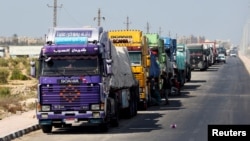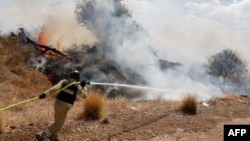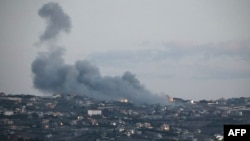US continues to engage with Egypt, Qatar on revised Gaza cease-fire proposal

The United States is actively engaging with key regional partners, most specifically with Egypt and Qatar, to present a revised proposal for a Gaza cease-fire.
While a timetable for the proposal, anticipated to be several weeks, has not been provided, State Department spokesperson Matthew Miller told reporters on Monday that Washington is working expeditiously to ensure the proposal leads to “an ultimate agreement” between Israel and Hamas.
Earlier on Monday, U.S. Secretary of State Antony Blinken met with Yair Lapid, Israel’s opposition leader and former prime minister.
After the meeting at the State Department, Lapid told reporters that Israel needs a hostage deal and an end to the war in Gaza, emphasizing that no political process or turbulence should affect the deal. Lapid urged the U.S. not to let Hamas “skirt a hostage deal.”
“Israel as a nation will not heal unless we will bring them (the remaining hostages) back home. This is essential to our existence,” Lapid said.
Humanitarian efforts
At the United Nations Security Council, Sigrid Kaag, the U.N. senior humanitarian and reconstruction coordinator for Gaza, gave a bleak briefing on the situation of Palestinian civilians.
“Time is slipping away as a man-made humanitarian crisis has turned Gaza into the abyss,” she said. “It cannot be repeated enough: We need an immediate cease-fire, the immediate and unconditional release of all hostages, and unimpeded, continuous humanitarian access to deliver aid at scale throughout the Gaza Strip.”
She said relief operations are hampered by hostilities, lawlessness, and denials and delays by the Israeli authorities.
Data from the U.N. office of humanitarian affairs shows that the number of aid trucks getting into Gaza each day has steadily decreased from a high in April of 169 trucks a day. That has dropped to 69 trucks a day in August, and 62 a day during the first nine days of September.
Israel denies that it impedes aid deliveries.
“We have gone above and beyond our obligations, aiming to improve the well-being of a civilian population embedded within the enemy,” Israel’s U.N. Ambassador Danny Danon said.
Fighting
Separately, Israeli airstrikes killed 16 people in the Gaza Strip early Monday, according to Palestinian officials, and took out 20 Hezbollah launchers and military infrastructure sites in southern Lebanon, the Israel Defense Forces said.
The Gaza airstrikes hit a home in the Nuseirat refugee camp in central Gaza, killing at least 10 people and wounding 13 others. Six other people were killed in a strike on a Gaza City home, first responders who operate under the Hamas-run government told the Associated Press.
The dead included four women and two children.
The Israeli military reported that after sirens sounded in the area of the Upper Galilee, two suspicious aerial targets were identified crossing from Lebanon into Israeli territory and falling in the area of the northern Golan Heights.
The air force struck “approximately 20 Hezbollah launchers and military infrastructure sites which posed an immediate threat to Israeli civilians” in the area of Jarmaq in southern Lebanon.
Tensions are high along the Israel-Lebanon border. A senior U.S. envoy, Amos Hochstein, is reported to be back in the region Monday, meeting officials in Israel.
Israeli Prime Minister Benjamin Netanyahu said Sunday that the current situation along the Israeli-Lebanon border, where tens of thousands of people have been displaced, is not sustainable.
“The existing situation will not continue. We will do everything necessary to return our residents safely to their homes,” he said.
On Sunday, Iranian-backed Houthi rebels in Yemen fired drones and missiles toward Israel that landed in an open area in central Israel.
On Monday, Hamas leader Yehya Sinwar congratulated the Houthis, according to the rebel’s media wing.
Sinwar said that Israel’s plans to destroy Hamas had failed.
“I assure you that the resistance is fine,” he said. “We have prepared ourselves to fight a long battle of attrition.”
Gerald Feierstein, retired ambassador and director of the Arabian Peninsula program at the Middle East Institute, told VOA on Monday that “the big issue is that clearly the Houthis’ capability to undertake these strikes is a result of their cooperation with Iran.”
He added at some point, Israel may decide that striking back at the Houthis is not enough, and that they need to engage Iran directly.
“These are the concerns keeping everyone on edge, as it raises the potential for a broader regional conflict beyond Gaza,” Feierstein said.
The Houthis are among several Iran-backed groups in the Middle East that have been drawn into the conflict triggered by Hamas’ shock attack on southern Israel last October 7 that killed 1,200 people and led to the capture of 250 hostages. Israel’s counteroffensive in Gaza has killed more than 41,000 Palestinians, a death toll Israel says includes several thousand militant fighters.
Hamas has been designated a terror group by the U.S., the U.K., EU and other Western nations.
VOA State Department Bureau Chief Nike Ching, U.N. correspondent Margaret Besheer, Kim Lewis and Natasha Mozgovaya contributed to this report.
Related
Qatar emphasizes importance of reaching agreement between US, Iran
CAIROQatar's Prime Minister Sheikh Mohammed bin Abdulrahman Al-Thani stressed the critical need for an agreement between the US and
International Women’s Day: Seeking a Balance with Ghada Al Subaey
1309’s Ghada Al Subaey of Qatar celebrates the many layers of femininity in her recent drop, called Labyrinth of Light. This International Women’s Day, the
Discover Ooredoo Plans and Services in Qatar
Ooredoo is the household name in the field of telecommunications and provides a full portfolio of telecom services: mobile plans for everyone, home
What Will The Imminent Qatar Airways Widebody Order Include?
Which Airline Alliance Do You Prefer To Fly With?















